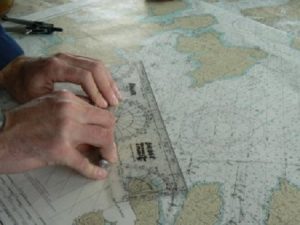Forespar's Point of View
Blogging About Life on the WaterTag Archives: hand bearing
What Do You Do If the Battery Quits?
So, you’re half way to the Island. It’s just after 10 pm, with no moon yet. It’s bumpy, and the visibility is poor. The 15 knot breeze is westerly, and the swell and wind waves are southwest. You know you’re getting pushed off course, but that’s OK, since both diesels are thumping away, and the GPS is telling where you are (and what to steer to get to the mooring).
Then, the instruments go dark. Yikes! Now what?

You have a compass mounted by the wheel. You whip out the Chart Book, grab your pencil and mark the last GPS position on the chart, then use your parallels to pencil a line to your destination. Then down to the compass rose, and determine a fair approximation of the compass course to the destination. Steer that course, and you’re good.
Oh, wait.
You don’t have charts, parallels, etc. And if you did, you don’t know how to use the low tech. You may just want to go real slow and listen for surf, and look for the red/green flashers at the harbor entrance. Not at all what you’ve planned, and not at all fun, even if it works out.
The kids, and grand-kids have asked “What are you doing?” when they see me using the hand-bearing compass for a quick sight at a point of land, make a line on the chart, and repeat the process in another direction. I’d explain that where those lines cross is where we are – on the chart, and then explain the cross bearing, and how I got it, and how simple it really is. Or, that same question when I scribble the time, course direction and speed when we’ve just cleared the harbor entrance, and an hour later walk over to the chart and draw a line, scribble some more, use the dividers, and draw an x. I give a quick explanation of dead reckoning, and how easy it is (and always a good idea on that dark night or foggy day).
The next question was always “Why do you do that if you have a GPS?” And answer always is “This will tell me where we are”. No, it’s not as accurate as the WAAS GPS and the Chart Plotter. But close enough if you’re talking to the Coast Guard (hope that doesn’t happen). It was good enough before the electronics, and basic navigation still works – inexpensive, quick and easy use and easy to learn.
What do YOU do if the battery quits?
RSS Subscription
Archives
- September 2018
- August 2018
- July 2018
- February 2018
- January 2018
- December 2017
- November 2017
- August 2017
- June 2017
- May 2017
- April 2017
- March 2017
- February 2017
- January 2017
- November 2016
- October 2016
- September 2016
- August 2016
- July 2016
- June 2016
- May 2016
- April 2016
- March 2016
- February 2016
- January 2016
- June 2015
- May 2015
- April 2015
- March 2015
- February 2015
- January 2015
- December 2014
- November 2014
- October 2014
- September 2014
- August 2014
- July 2014
- June 2014
- April 2012
- March 2012
- October 2010
- August 2010
- July 2010
- June 2010
Blogroll